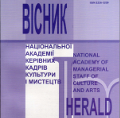«ДВІ ЛЕГЕНДИ» ДЛЯ ФОРТЕПІАНО ПІЗНЬОГО ПЕРІОДУ ТВОРЧОСТІ Ф. ЛІСТА В РІЧИЩІ ДУХОВНО-ЕСТЕТИЧНИХ ПОГЛЯДІВ КОМПОЗИТОРА
"TWO LEGENDS" FOR PIANO BY F. LISZT IN LINE WITH HIS SPIRITUAL AND AESTHETIC POSITIONS
Author(s): Yevheniia BeinykSubject(s): Cultural history, Music, Aesthetics, 19th Century, History of Art
Published by: Національна академія керівних кадрів культури і мистецтв
Keywords: legend; romanticism; symbolism; musical style; musical genre; musical symbols;
Summary/Abstract: The purpose of the study is to investigate the poetic and intonation features of “Two Legends” for the piano in the context of spiritual search and to reveal the compositional guidelines of F. Liszt, aimed at embodying the poetry of non-antithetical content. The research methodology is determined by the use of historical-logical, analytical, cultural, hermeneutic, comparative methods, as presented in the works of representatives of the intonation approach of B. Asafiev in Ukraine – in the works of D. Androsova, O. Markova, O. Muravska, O. Roschenko, and O. Socol. Scientific novelty. For the first time in domestic cultural studies, the specifics of F. Liszt's spiritual ideas are highlighted according to their presentation in the named piano spiritual works of the late period of the composer's work, marked by his approach to the symbolic principles of thinking. Сonclusions. The analysis of the symbolic meaning of the music of F. Liszt's “Two Legends” for piano showed that these are works based on the choice of the program plot – life descriptions of the images of the Saints – Francis of Assisi (XIII century) and the follower of the first Francis of Paoli (XV century), who represented the closely related to Byzantine Orthodoxy, the discovery of mysticism and aestheticism in Catholicism. In the compositional solution, monophonic recitatives (the theme-image of Francis of Assisi in the First Legend), the motif of the Cross, which in the context of the program acquires an interpretation in the aspects of the Old Christian confession, are essential. The tonus peregrinus in the leitmotif of St. Francis in “Second Legend” also stands out, testifying to the imitation of the old liturgy of Byzantine origin. Compositionally, this poetry affirms the Divine unity of the world, in this case it is a presentation of a form devoid of thematic antitheticity. In his spiritual works, Liszt turns to the two-part nature of non-contrasting juxtapositions, which model compositional primary liturgical features.
Journal: Вісник Національної академії керівних кадрів культури і мистецтв
- Issue Year: 2023
- Issue No: 3
- Page Range: 230-235
- Page Count: 6
- Language: Ukrainian

